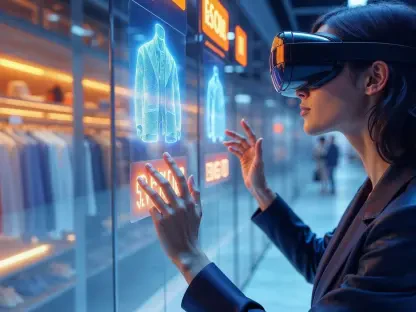E-commerce, short for electronic commerce, refers to buying and selling goods and services over the Internet. Over the past few years, it has transformed how businesses operate—and revolutionized the shopping experience for consumers worldwide. In today’s digital age, e-commerce has become an integral part of our daily lives, offering convenience, accessibility, and a vast array of options.
The growth of e-commerce has been driven by numerous advancements in technology: secure payment gateways, robust logistics networks, and user-friendly interfaces. Online platforms now offer a seamless shopping experience, delighting customers with personalized recommendations, easy payment options, and fast shipping.
As e-commerce continues to evolve, new trends and technologies such as artificial intelligence, augmented reality, and voice commerce are reshaping the industry. In this article, we’ll discuss these innovations and explore how they enhance customer experiences, streamline operations, and further blur the boundaries between online and offline retail.
Artificial intelligence (AI)
Artificial intelligence (AI) is revolutionizing the e-commerce industry, shaping how businesses operate and transforming the customer experience. In the upcoming years, AI is poised to play a critical role in driving innovation and the growth of online retail.
One area where AI is making a profound impact is personalized marketing and customer engagement. AI algorithms can analyze vast amounts of customer data, including browsing behavior, purchase history, and demographics. Doing so provides businesses with targeted product recommendations, personalized offerings, and tailored marketing messages. This level of personalization enhances customer satisfaction, increasing conversion rates and fostering loyalty.
Additionally, AI-powered chatbots and virtual assistants are becoming irreplaceable in e-commerce, empowering companies with instant and personalized support that guides customers through the purchase journey and offers insightful recommendations. Chatbots can handle a high volume of customer interactions simultaneously, providing efficient and round-the-clock assistance—ultimately reducing operational costs.
Furthermore, AI is becoming a core investment for inventory management and supply chain operations. AI algorithms can predict demand patterns, optimize inventory levels, and automate replenishment processes, ensuring organizations can meet customer expectations while limiting excess stock and minimizing costs. AI-driven logistics and delivery systems also improve efficiency and accuracy, empowering the customer experience (CX) journey through real-time tracking and the optimization of delivery systems.
Augmented Reality (AR) and Virtual Reality (VR)
In today’s digital-driven business landscape, AR allows customers to visualize products in their own environment before making a purchase. By using smartphone cameras or wearable devices, shoppers can try on virtual clothing, place furniture in their homes, or even assess how cosmetics would look on their unique features. This helps eliminate uncertainties and increases confidence in purchasing decisions.
Conversely, VR transports customers to virtual environments where they can explore and interact with products in a simulated setting. It enables virtual showrooms, tours, and try-on experiences. VR creates a sense of presence that closely mimics real-world interactions.
Both AR and VR provide unique opportunities for businesses to better engage with their customers, increase sales, and differentiate themselves in a competitive marketplace. As AR and VR technologies continue to evolve, e-commerce leaders should expect shopping experiences to become increasingly immersive and visually captivating, transforming how customers interact with their favorite brands.
Voice Commerce
With the rise of voice assistants like Amazon’s Alexa, Google Assistant, and Apple’s Siri, voice e-commerce has become increasingly prevalent. Through the usage of voice commands, customers can search for products, place orders, and make payments seamlessly. This niche technology offers convenience, speed, and hands-free interaction, making it particularly appealing for busy consumers or those with limited mobility.
Voice assistants leverage natural language processing and machine learning to accurately understand and interpret user queries. They can provide personalized recommendations, track order statuses, and even remember previous purchases, creating a personalized and frictionless shopping experience.
As voice recognition technology improves and more devices integrate voice assistants, voice commerce becomes more accessible and widely adopted. To adapt, retailers should optimize their websites and apps for voice search, ensuring compatibility with voice-enabled devices.
Voice commerce also extends beyond the purchase process. By using voice assistants, businesses can provide post-purchase support, offer product information, and help with customer inquiries—thus enhancing consumer satisfaction and loyalty.
Internet of Things (IoT)
IoT devices are becoming ubiquitous, with an ever-growing impact on the success and performance of e-commerce businesses. Connected devices like smart refrigerators, wearable devices, and home automation systems bring a new level of comfort to many modern families worldwide.
Furthermore, IoT enhances the supply chain and logistic processes by enabling real-time tracking of shipments, optimizing delivery routes, and improving inventory management. This results in streamlined operations, reduced costs, and faster order fulfillment.
As IoT technology advances, it will further integrate with e-commerce platforms, allowing for seamless connectivity and enhanced functionalities. The possibilities are vast, ranging from smart dressing rooms that provide personalized recommendations to delivery drones that bring products directly to customers’ doorsteps.
Mobile Commerce
With the widespread adoption of smartphones and tablets, mobile devices have become the preferred platform for accessing the Internet and making purchases.
Mobile commerce (M-commerce) offers unparalleled convenience and flexibility. Customers can browse products, compare prices, and make purchases anytime and anywhere, eliminating the constraints of physical stores and desktop computers. To adapt and continue providing seamless user experiences, businesses are compelled to optimize their websites and apps for mobile devices.
Additionally, the rise of mobile wallets and payment options (such as Apple Pay, Google Pay, and digital wallets from various financial institutions) has also accelerated the growth of m-commerce. These secure and convenient payment methods enable quick and hassle-free transactions, enhancing the overall customer experience.
These new advancements in mobile technology are not limited to traditional applications. In fact, retailers are increasingly adopting augmented reality (AR) and location-based services. AR allows customers to virtually try on products or visualize items in their surroundings, while location-based services enable personalized offers and promotions based on a customer’s geographic location.
Blockchain Technology
Blockchain technology is becoming a critical asset in enhancing security and trust in online transactions. By utilizing cryptographic algorithms and distributed ledger technology, blockchain ensures the integrity and authenticity of data. It also reduces the risk of fraud, counterfeiting, and data manipulation, instilling confidence in customers and businesses alike.
Through blockchain, customers can verify the authenticity and quality of products, ensuring they are purchasing genuine items. This is particularly important in industries such as luxury goods, pharmaceuticals, and food safety. Smart contracts, powered by blockchain, automate and enforce contract terms, eliminating the need for intermediaries and streamlining payment processes.
Moreover, blockchain enables new business models, such as peer-to-peer marketplaces and tokenization of assets. It facilitates direct and secure transactions between buyers and sellers without the need for traditional intermediaries. Tokenization allows assets to be presented digitally, enabling fractional ownership and unlocking liquidity for formerly illiquid assets.
Conclusion
A convergence of powerful technologies will shape the e-commerce landscape in 2023 and beyond. Artificial intelligence, blockchain, IoT, VR, AR, and data analytics are set to revolutionize e-commerce. Businesses that embrace and leverage these technologies will gain a competitive advantage and position themselves for success in the dynamic world of e-commerce.









